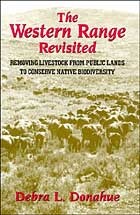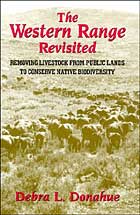Whatever might be said of the arid West, it “ain’t no cow country.” That’s what Henry Fonda, playing Wyatt Earp, said of Arizona in John Ford’s 1946 film My Darling Clementine.

That’s also the bottom line of a book I’ve written, The Western Range Revisited: Removing Livestock from Public Lands to Conserve Native Biodiversity. In it, I conclude that where mean annual precipitation is 12 inches or less, livestock should be removed from large tracts of federal lands managed by the Bureau of Land Management.
Fonda’s judgment was based on eyeballing. My case is based on modern understandings of dryland range ecology and conservation biology, and on history, economics, and the law.
My starting premise is that the BLM has ignored the 1934 Taylor Grazing Act’s direction that public lands be allocated to grazing only if they are “chiefly valuable for grazing.” The legislative history reveals that Congress was acutely aware that many Western ranges were severely degraded by overstocking and that many desert lands were simply unsuited to livestock use.
Yet today 170 million acres of BLM lands are grazed, and they produce only a tiny fraction of the nation’s animal products. Moreover, these lands are required by law to be managed for sustained yield of numerous, higher value resources (such as wildlife and watershed), without impairment of the land’s productivity. But most BLM rangelands remain in only fair or poor condition; ecologically valuable riparian areas are in their worst condition ever.
We’ve never had an honest debate on this issue. Federal land agencies have been unwilling or unable to resist the disproportionate political influence long wielded by Western livestock interests. Grazing advocates distort or ignore the economic facts and the science, rely on cultural and historical myths to defend their “way of life,” and extort public support with dire predictions of subdivision development of private lands if public range privileges cease. Some conservation groups buy into the “cows versus condos” ploy and share the blind allegiance to the mythical West, thus excluding the elimination of grazing as a choice.
My book has caused a ruckus here in Wyoming. State Sen. Jim Twiford (R) announced that he would introduce a bill eliminating the University of Wyoming law school where I work (though he has subsequently dropped the proposal). A rancher and former gubernatorial candidate who has not seen the book called it “garbage.” One rancher scoffed: “With a title like hers, do we really need to spend $50 to read the rest?”
This attitude, along with the issue of my university president’s support (or lack of support) for academic freedom, may, unfortunately, doom any prospect for a much-needed discussion on the merits.
The most facially credible attack on the book came from the University of Wyoming Renewable Resources Department head, Thomas Thurow. “Do livestock pose an inherent threat to sustainable rangeland ecosystems?” he queried in a recent op-ed piece in the Casper Star-Tribune. His answer — an emphatic “No!” — was based on reasoning that Western ranges “developed with large grazing animals present.”
But most of the lands targeted by my book did not develop in the presence of large herds of bison or other large ungulates. And even where bison once were present, cattle cannot be considered as mere substitutes for the native grazer. Cattle and bison have different diets and different foraging patterns. Bison were migratory, often not returning to a particular area for years. Bison didn’t congregate in stream bottoms. And they weren’t managed by humans in ways that exacerbated their negative effect on plants and soils.
Thurow admits that “any grazing is harmful” in “extreme desert ecosystems where large animals were not an important historical component.” His implication is that few lands qualify. But lands susceptible to livestock damage include not just “extreme deserts,” but all lands within the 12-inch moisture isoline. That’s the vast majority of BLM holdings in the West.
Thurow argues that the solutions to grazing-abused ranges are “proper stocking rates and use patterns.” But there is no “proper stocking rate” for exotic species. Nonnative livestock, themselves “exotics,” will (in any numbers) contribute to the introduction and spread of exotic organisms and compete with native species for forage, water, and cover. Range ecologists now agree that grazing beyond certain thresholds causes irreversible ecological changes to arid and semiarid lands. Millions of acres in the West have been pushed beyond these thresholds. Cheatgrass-infested ranges are prime examples.
The writing is on the wall: Livestock grazing on semiarid public ranges is uneconomic and unsustainable. The only solution is removing livestock altogether.
Henry Fonda, alias Wyatt Earp, had it right. This “ain’t no cow country.”


